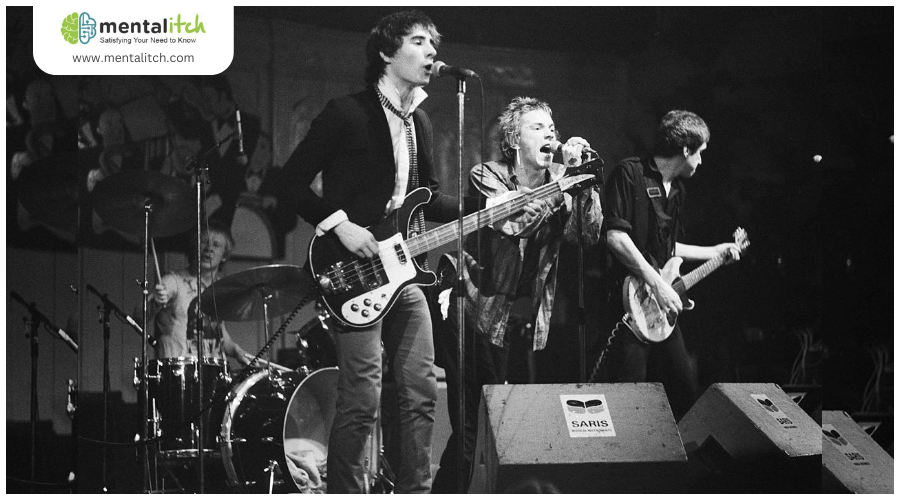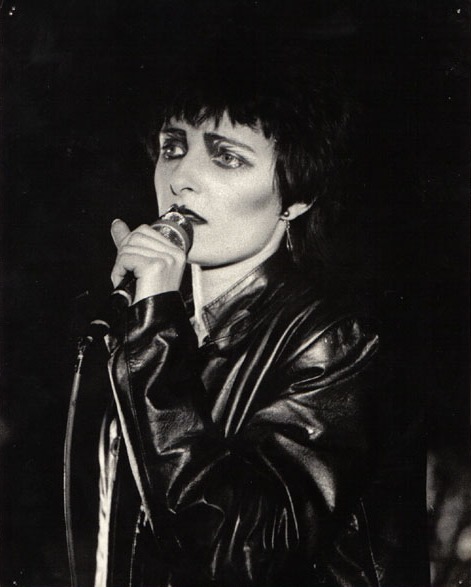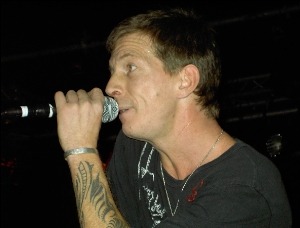British punk rock in the 1970s was more than just a musical genre; it was a cultural revolution that shook the foundations of British society. Emerging from the gritty streets of London, punk bands expressed raw energy and defiance, capturing the disillusionment of a generation.
Which bands were the most influential in this pivotal decade, and how did they shape the punk movement? This article explores the ten British punk bands from the 70s that left an indelible mark on music and culture, setting the stage for future generations.
1) The Clash
The Clash formed in London in 1976. They were led by Joe Strummer on vocals and guitar. Alongside him were Mick Jones, Paul Simonon, and Topper Headon.
Known as “The Only Band That Matters,” The Clash were pioneers of British punk rock. They fused punk with reggae, ska, and funk. This made their sound unique and influential.
Their lyrics often addressed social issues and politics. Tracks like “London Calling” and “White Riot” are famous examples. These songs captured the spirit of rebellion and change.
Throughout their career, The Clash played energetic live shows. They became symbols of intelligent protest and stylish rebellion. Their music continues to inspire new generations.
By blending different genres and tackling serious themes, The Clash left a lasting impact on music. Their work remains essential listening for anyone interested in punk rock.
2) Sex Pistols
The Sex Pistols, formed in London in 1975, are often considered one of the most iconic punk bands. Their music and image were rebellious and raw, resonating with the social and political unrest in the UK at the time.
Despite their brief initial run of just two and a half years, the band’s impact was immense. They kick-started the punk movement in the UK and influenced many future punk and alternative bands.
Their most famous song, “God Save the Queen,” caused controversy with its criticism of the British monarchy. This song elevated their status as symbols of rebellion.
Johnny Rotten (John Lydon) led the band with his distinct vocals. Steve Jones played guitar, Paul Cook was the drummer, and Glen Matlock was the original bassist, later replaced by Sid Vicious.
The Sex Pistols’ style—both musically and fashion-wise—left a lasting mark. The torn clothes, safety pins, and spiky hair became visuals synonymous with punk culture. Their debut album, “Never Mind the Bollocks, Here’s the Sex Pistols,” is a landmark record in punk music.
Their legacy endures, representing the raw, anti-establishment spirit of 70s punk in Britain.
3) The Damned
Formed in London in 1976, The Damned quickly made their mark on the British punk rock scene. They are known for releasing the first punk single in the UK, “New Rose,” in 1976. This track set the stage for the punk movement in Britain.
The Damned brought a mix of fast-paced energy and dark humor to their music. Their debut album, “Damned Damned Damned,” released in 1977, showcased their raw sound and rebellious spirit. This album includes hits like “Neat Neat Neat” and “New Rose.”
Their live performances were wild and unpredictable, often involving chaotic stage antics. The Damned’s concerts became legendary for their sheer intensity and raw energy. Fans were drawn to their reckless abandon and unfiltered attitude.
Despite internal conflicts and lineup changes over the years, The Damned has continued to influence punk and alternative music. Their fusion of punk rock with elements of gothic and psychedelic music set them apart from their contemporaries. This unique blend has inspired countless bands that followed.
4) Buzzcocks
Buzzcocks formed in 1976 in Bolton, Lancashire. They quickly became one of the most influential punk bands of their time. Known for their catchy melodies and driving guitars, they carved out a unique space in the punk genre.
Their song “Boredom” from the Spiral Scratch EP in 1977 stood out. It expressed their frustration with both the mainstream rock scene and the punk scene itself. This made them relatable to a wide audience.
Pete Shelley’s biting lyrics were a hallmark of the band. His words often dealt with real emotions and situations. This added a layer of authenticity to their music.
Not just limited to basic punk sounds, Buzzcocks infused pop elements into their music. This combination made their songs more accessible and enduring. Their influence can be seen in many bands that followed.
Buzzcocks are also known for their compilation album Singles Going Steady. Released in 1979, it’s often listed among the greatest punk albums. This album helped solidify their place in punk history.
They continue to perform and celebrate their legacy. Their 45th anniversary of Singles Going Steady marks a significant milestone. This shows their lasting impact on punk music.
Buzzcocks’ relevance in punk history remains undeniable. Their songs and style still resonate with fans today.
5) Siouxsie and the Banshees
Siouxsie and the Banshees formed in London in 1976. Fronted by Siouxsie Sioux and bassist Steven Severin, they quickly made a name for themselves in the punk scene.
Their music was unique and stood out due to its dark, haunting melodies and innovative guitar work. Songs like “Hong Kong Garden” and “Spellbound” showcased their originality.
Their debut album, The Scream, received critical acclaim and influenced many other bands. It combined punk’s raw energy with experimental sounds.
Siouxsie and the Banshees continued to evolve their style, incorporating elements of post-punk and gothic rock. Albums such as Juju and Kaleidoscope reflected their growth as artists.
The band’s impact on the music world is significant. They inspired artists across various genres, and their influence is still felt today.
6) Sham 69
Sham 69 formed in Hersham, Surrey, in 1975. They were inspired by the energy and raw sound of the Sex Pistols, whom they saw live in 1976. This led them to adopt a punk rock style that quickly garnered attention.
The band was known for their passionate and straightforward youth anthems. Songs like “If the Kids Are United” and “Hurry Up Harry” became rallying cries for young fans. These tracks captured the rebellious spirit of the late 70s punk scene.
Sham 69 achieved significant commercial success in the UK. They had five top 20 singles, which was quite a feat for a punk band at that time. Their music was characterized by catchy melodies and simple, yet powerful lyrics.
Led by the charismatic Jimmy Pursey, Sham 69’s performances were energetic and engaging. Pursey’s presence and the band’s anthemic songs helped solidify their place in punk history. They were not just musicians but also voices of their generation.
Despite various lineup changes over the years, Sham 69’s impact on punk rock remains. They influenced many bands that followed and left an indelible mark on the genre. Their songs continue to be celebrated for their raw authenticity and emotional resonance.
7) X-Ray Spex
X-Ray Spex was a punk rock band from London, formed in 1976. They are best known for their energetic sound and socially conscious lyrics. The band’s frontwoman, Poly Styrene, was one of the first female punk vocalists, adding a unique voice to the genre.
Their song “Oh Bondage Up Yours!” became an anthem, addressing issues of consumerism and personal freedom. This single, released in 1977, quickly gained acclaim and remains a punk classic.
In 1978, X-Ray Spex released their debut album, Germfree Adolescents. The album received widespread praise and solidified their place in punk history. It tackled themes of artificiality and identity in modern society.
Despite their short career, X-Ray Spex had a lasting impact. They broke new ground with their blend of punk energy and thought-provoking lyrics. Their music continues to inspire new generations of punk fans.
8) The Stranglers
The Stranglers were formed in Guildford, Surrey, in 1974. Originally known as the Guildford Stranglers, they quickly built a following within the mid-1970s pub rock scene.
They stood out for their unique blend of punk with new wave and post-punk elements. Their music often featured shimmering synths and classical guitar, setting them apart from their peers.
Their early work includes the controversial album “No More Heroes” and the hit singles “Peaches” and “European Female.” The band’s provocative lyrics and aggressive sound pushed punk’s boundaries.
With 23 UK top 40 singles and 19 UK top 40 albums, The Stranglers are one of the longest-surviving bands from the UK punk scene. Their impact on punk rock’s evolution remains significant.
9) Stiff Little Fingers
Stiff Little Fingers formed in Belfast, Northern Ireland in 1977. The band emerged during the height of the punk movement and quickly made a name for themselves with their energetic and politically charged music.
They gained recognition for their raw sound and powerful lyrics, often reflecting the political climate and social issues of the time.
Their debut album, “Inflammable Material,” released in 1979, included standout tracks like “Alternative Ulster” and “Suspect Device.” These songs captured the frustration and anger of youth in Northern Ireland and became anthems for the punk rock scene.
Stiff Little Fingers were notably influenced by the Troubles in Northern Ireland, drawing inspiration directly from their experiences. Their music often addressed themes of conflict and unrest, resonating deeply with audiences both locally and internationally.
The band was also known for their energetic live performances. They managed to cultivate a dedicated fan base despite the challenging and often violent environment they grew up in. Their music provided a voice for many who felt overlooked and oppressed.
Throughout their career, Stiff Little Fingers remained true to their punk roots while exploring different musical styles. They continued to produce new material and perform live, earning a lasting legacy as one of the most influential punk bands of the 70s.
10) Generation X
Generation X was an English punk band formed in London in 1976. The group consisted of Billy Idol, Tony James, Bob Andrews, and Mark Laff. They were known for combining the raw energy of punk with a more polished, pop-influenced sound.
Their debut single, “Your Generation,” was released in 1977 and quickly made a mark on the UK Singles Chart. This paved the way for their self-titled debut album, which featured catchy tracks like “Ready Steady Go” and “Wild Youth.”
Generation X stood out by making punk accessible to a broader audience. While they were rough around the edges, their music often had a melodic, upbeat feel. Billy Idol’s charismatic stage presence further boosted their popularity.
The band switched to Chrysalis Records and released another successful album, Valley of the Dolls. Despite not enjoying the same level of commercial success as some of their contemporaries, Generation X left a lasting impact on the punk genre and helped popularize the movement. Their music continues to influence new generations of punk and rock artists.
Historical Context of the 70s British Punk Scene
The British punk scene of the 1970s emerged from a landscape marked by economic hardship and political unrest. This movement was fueled by a deep dissatisfaction with the status quo, both musically and socially.
Origins and Evolution
British punk began as a reaction to the mainstream music and cultural norms of the time. Influenced by the raw sound of American bands like The Ramones, British artists sought to create a scene that was distinctively their own.
The late 1970s saw the rise of iconic punk venues such as The Roxy and 100 Club, where bands like the Sex Pistols and The Clash made their mark. DIY culture became the norm, with bands producing their own music and zines. This grassroots approach led to a sense of community and authenticity that set punk apart from other genres.
Social and Political Influences
The socio-economic climate of the UK in the 1970s played a crucial role in shaping the punk movement. High unemployment rates and economic decline left many young people feeling disenfranchised. Political issues, such as strikes and government austerity measures, added to the general sense of unrest.
Punk bands often addressed these issues in their music and public appearances. Songs like “Anarchy in the UK” by the Sex Pistols captured the frustration and anger of the youth. The punk scene also clashed with established norms, leading to controversies and moral panic in the media.
This defiance was not just about rebellion but also about seeking change and expressing a desire for a different future.
Key Characteristics of 70s British Punk Music
British punk music of the 70s stood out for its fast tempos, aggressive sound, DIY ethos, and unique fashion. The influence of punk extended beyond music to include a distinct visual style.
Musical Style and Influences
British punk music of the 70s was characterized by fast-paced tempos and often short, simple songs. Bands typically used a basic setup of guitar, bass, and drums, creating a raw, unpolished sound. The lyrics often focused on social and political themes, expressing discontent and rebellion.
Influences came from earlier rock and roll as well as garage rock bands. Groups like The Sex Pistols and The Clash fused this with a new, confrontational attitude. This combination helped define punk’s distinct musical identity, making it easily recognizable by its aggressive, energetic style.
Fashion and Visual Aesthetics
Punk wasn’t just about the music; it was also about making a visual statement. Punk fashion of the 70s included items like ripped clothes, safety pins, leather jackets, and band t-shirts. This style was often paired with bold hairstyles such as brightly colored hair or mohawks.
Punk visual aesthetics were aimed at shocking and challenging societal norms. The DIY ethic extended to fashion, with many punks creating their own clothing or modifying existing pieces. Figures like Vivienne Westwood were instrumental in shaping this look, which remains iconic in popular culture.


